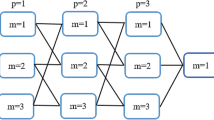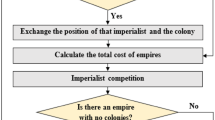Abstract
An accurate estimation of deep foundation bearing capacity in different types of soils with the aid of the field experiments results is taken into account as the most important problems in geotechnical engineering. In recent decade, applying a broad range of artificial intelligence (AI) models has become widespread to solve various types of complicated problems in geotechnics. In this way, this study presents an application of two improved adaptive neuro-fuzzy inference system (ANFIS) techniques to estimate ultimate piles bearing capacity on the basis of cone penetration test (CPT) results basically used in analysis of pile foundations. The first model was combination of ANFIS and group method of data handling (GMDH) and the second one was related to the integration of fuzzy polynomial (FP) and GMDH model. Furthermore, in the ANFIS–GMDH, constant coefficients of ANFIS model were optimized using gravitational search algorithm (GSA). To improve the proposed AI models for carrying out training and testing stages, a reliable database in form of four input variables included information about different properties of soils and driven piles obtained from CPTs results. Performance of the proposed approaches indicated that FP–GMDH had better performance (RMSE = 0.0647 and SI = 0.378) in comparison with ANFIS–GMDH–GSA (RMSE = 0.084 and SI = 0.412). The use of multiple linear regression and multiple nonlinear regression equations showed lower level of precision in prediction of axial-bearing capacity of driven piles compared to the ANFIS–GMDH–GSA and FP–GMDH techniques.





Similar content being viewed by others
References
Abu-Kiefa M (1998) General regression neural networks for driven piles in cohesionless soils. J Geotech Geoenviron Eng 124(12):1177–1185
Ahangar-Asr A, Javadi AA, Khalili N (2014) A new approach to thermo-mechanical modelling of the behaviour of unsaturated soils. Int J Numer Anal Methods Geomech 39:539–557
Alavi AH, Gandomi AH (2012) A new multi-gene genetic programming approach to nonlinear system modeling. Part I: materials and structural engineering problems. Neural Comput Appl 21(1):171–187
Alavi AH, Ameri M, Gandomi AH, Mirzahosseini MR (2011) Formulation of flow number of asphalt mixes using a hybrid computational method. Constr Build Mater 25(3):1338–1355
Alkroosh IS, Nikraz H (2011a) Correlation of pile axial capacity and CPT data using gene expression programming. Geotech Geol Eng 29(5):725–748
Alkroosh IS, Nikraz H (2011b) Predicting axial capacity of driven piles in cohesive soils using intelligent computing. Eng Appl Artif Intell 25(3):618–627
Alkroosh IS, Nikraz H (2012) Predicting axial capacity of driven piles in cohesive soils using intelligent computing. Eng Appl Artif Intell 25(3):618–627
Alkroosh IS, Nikraz I (2013) Evaluation of pile lateral capacity in clay applying evolutionary approach. Int J Geomath 4(1):462–465
Alkroosh I, Nikraz H (2014) Predicting pile dynamic capacity via application of an evolutionary algorithm. Soils Found 54(2):233–242
Alkroosh IS, Bahadori M, Nikraz H, Bahadori A (2015) Regressive approach for predicting bearing capacity of bored piles from cone penetration test data. J Rock Mech Geotech Eng 7(5):584–592
Amanifard N, Nariman-Zadeh N, Farahani MH, Khalkhali A (2008) Modelling of multiple short-length-scale stall cells in an axial compressor using evolved GMDH neural networks. J Energy Convers Manag 49(10):2588–2594
Armaghani DJ, Raja RSNSB, Faizi K, Rashid ASA (2017) Developing a hybrid PSO–ANN model for estimating the ultimate bearing capacity of rock-socketed piles. Neural Comput Appl 28(2):391–405
Bezdek JC (1973) Cluster validity with fuzzy sets. J Cybern 3:58–73. https://doi.org/10.1080/01969727308546047
Cevik A (2007) Unified formulation for web crippling strength of cold-formed steel sheeting using stepwise regression. J Constr Steel Res 63(10):1305–1316
Cevik A (2011) Modeling strength enhancement of FRP confined concrete cylinders using soft computing. Expert Syst Appl 38(5):5662–5673
Ebrahimian B, Movahed V (2017) Application of an evolutionary-based approach in evaluating pile bearing capacity using CPT results. Ships Offshore Struct 12(7):937–953
Farlow SJ (ed) (1984) Self-organizing method in modelling: GMDH type algorithm. Marcel Dekker Inc, New York
Fatehnia M, Tawfiq K, Hataf N, Ozguven EE (2015) New method for predicting the ultimate bearing capacity of driven piles by using Flap number. KSCE J Civil Eng 19(3):611–620
Gandomi AH, Alavi AH, Sahab MG (2010) New formulation for compressive strength of CFRP confined concrete cylinders using linear genetic programming. Mater Struct 43(7):963–983
Iba H, deGaris H (1996) Extending genetic programming with recombinative guidance. In: Angeline P, Kinnear K (eds) Advances in genetic programming, vol 2. MIT Press, Cambridge
Ivahnenko AG (1971) Polynomial theory of complex systems. IEEE Trans Syst Man Cybern 1(4):364–378
Jang JSR (1993) ANFIS: adaptive-network-based fuzzy inference system. IEEE Trans Syst Man Cybern 23(3):665–685
Józefiak K, Zbiciak A, Maślakowski M, Piotrowski T (2015) Numerical modelling and bearing capacity analysis of pile foundation. Procedia Eng 111:356–363
Kalantary F, Ardalan H, Nariman-Zadeh N (2009) An investigation on the Su–NSPT correlation using GMDH type neural networks and genetic algorithms. Eng Geol 104(1–2):144–155
Khandelwal M, Marto A, Fatemi SA, Ghoroqi M, Armaghani DJ, Singh TN, Tabrizi O (2018) Implementing an ANN model optimized by genetic algorithm for estimating cohesion of limestone samples. Eng Comput 34(2):307–317
Kohestani VR, Vosoughi M, Hassanlourad M, Fallahnia M (2017) Bearing capacity of shallow foundations on cohesionless soils: a random forest based approach. Civil Eng Infrastruct J 50(1):35–49
Kordjazi A, Nejad FP, Jaksa M (2014) Prediction of ultimate axial load-carrying capacity of piles using a support vector machine based on CPT data. Comput Geotech 55:91–102
Lee IM, Lee JH (1996) Prediction of pile bearing capacity using artificial neural networks. Comput Geotech 18(3):189–200
Long JH, Wysockey MH (1999) Accuracy of methods for predicting axial capacity of deep foundations. In: Proceedings of OTRC 99 conference: analysis, design, construction, and testing of deep foundation ASCE, Austin, TX, 29–30 April, GSP 88, pp 190–195
Maizir H (2017) Evaluation of shaft bearing capacity of single driven pile using neural network. In: Proceedings of the international multiconference of engineers and computer scientists, vol I, IMECS, March 15–17, Hong Kong
McLachlan GJ, Do K-A, Ambroise C (2004) Analyzing microarray gene expression data. Wiley, Hoboken
Mehrara M, Moeini A, Ahrari M, Erfanifard A (2009) Investigating the efficiency in oil futures market based on GMDH approach. Expert Syst Appl 36(4):7479–7483
Moayedi H, Armaghani DJ (2018) Optimizing an ANN model with ICA for estimating bearing capacity of driven pile in cohesionless soil. Eng Comput 34(2):347–356
Mohanty R, Suman S, Das SK (2018) Prediction of vertical pile capacity of driven pile in cohesionless soil using artificial intelligence techniques. Int J Geotech Eng 12(2):209–216
Momeni E, Nazir R, Jahed Armaghani D, Maizir H (2014) Prediction of pile bearing capacity using a hybrid genetic algorithm-based ANN. Measurement 57:122–131
Najafzadeh M, Barani GA (2011) Comparison of group method of data handling based genetic programming and back propagation systems to predict scour depth around bridge pier. Sci Iran Trans A 18(6):1207–1213
Najafzadeh M, Saberi-Movahed F (2018) GMDH-GEP to predict free span expansion rates below pipelines under waves. Mar Georesour Geotechnol. https://doi.org/10.1080/1064119X.2018.1443355
Najafzadeh M, Tafarojnoruz A (2016) Evaluation of neuro-fuzzy GMDH-based particle swarm optimization to predict longitudinal dispersion coefficient in rivers. Environ Earth Sci 75(2):157
Najafzadeh M, Barani GA, Hessami-Kermani MR (2013a) Abutment scour in live-bed and clear-water using GMDH network. Water Sci Technol IWA 67(5):1121–1128
Najafzadeh M, Barani GA, Azamathulla HMd (2013b) GMDH to predict scour depth around vertical piers in cohesive soils. Appl Ocean Res 40:35–41
Najafzadeh M, Barani GA, Hessami Kermani MR (2013c) GMDH network based back propagation algorithm to predict abutment scour in cohesive soils. Ocean Eng 59:100–106
Najafzadeh M, Barani GA, Hessami-Kermani MR (2013d) Group method of data handling to predict scour depth around vertical piles under regular waves. Sci Iran 30(3):406–413
Najafzadeh M, Barani GA, Hessami-Kermani M-R (2013e) Group method of data handling to predict scour depth around vertical piles under regular waves. Sci Iran 20(3):406–413
Najafzadeh M, Barani GA, Hessami-Kermani MR (2014a) GMDH networks to predict scour at downstream of a ski-jump bucket. Earth Sci Inf 7(4):231–248
Najafzadeh M, Barani GA, Azamathulla HMd (2014b) Prediction of pipeline scour depth in clear-water and live-bed conditions using GMDH. Neural Compu Appl 24(3–4):629–635
Najafzadeh M, Barani GA, Hessami-Kermani MR (2014c) Estimation of pipeline scour due to waves by the group method of data handling. J Pipeline Syst Eng Pract ASCE 5(3):06014002
Najafzadeh M, Rezaie-Balf M, Rashedi E (2016a) Prediction of maximum scour depth around piers with debris accumulation using EPR, MT, and GEP models. J Hydroinf 18(5):867–884
Najafzadeh M, Etemad-Shahidi A, Lim SY (2016b) Scour prediction in long contractions using ANFIS and SVM. Ocean Eng 111:128–135
Najafzadeh M, Saberi-Movahed F, Sarkamaryan S (2017) NF-GMDH-Based self-organized systems to predict bridge pier scour depth under debris flow effects. Mar Georesour Geotechnol. https://doi.org/10.1080/1064119x.2017.1355944
Nariman-Zadeh N, Darvizeh A, Ahmad-Zadeh GR (2003) Hybrid genetic design of GMDH-type neural networks using singular value decomposition for modelling and prediction of the explosive cutting process. Proc Inst Mech Eng Part B J Eng Manuf 217(6):779–790
Oh S, Pedrycz W (2006) The design of self-organizing neural networks based on PNs and FPNs with the aid of genetic optimization and extended GMDH method. Int J Approx Reason 43:26–58
Onwubolu GC (2008) Design of hybrid differential evolution and group method in data handling networks for modeling and prediction. Inf Sci 178:3618–3634
Qin Y, Langari R, Gu L (2015) A new modeling algorithm based on ANFIS and GMDH. J Intell Fuzzy Syst 29(4):1321–1329
Rashedi E, Nezamabadi-Pour H, Saryazdi S (2009) GSA: a gravitational search algorithm. Inf Sci 179(13):2232–2248
Rashedi E, Nezamabadi-Pour H, Saryazdi S (2010) BGSA: binary gravitational search algorithm. Nat Comput 9(3):727–745
Rashedi E, Nezamabadi-Pour H, Saryazdi S (2011) Filter modeling using gravitational search algorithm. Eng Appl Artif Intell 24(1):117–122
Sakaguchi A, Yamamoto T (2000) A GMDH network using back propagation and its application to a controller design. J IEEE 4:2691–2697
Samui P, Shahin M (2014) Relevance vector machine and multivariate adaptive regression spline for modelling ultimate capacity of pile foundation. J Numer Methods Civil Eng 1(1):37–45
Sanchez E, Shibata T, Zadeh LA (1997) Genetic algorithms and fuzzy logic systems. World Scientific, Singapore
Shaghaghi S, Bonakdari H, Gholami A, Ebtehaj I, Zeinolabedini M (2017) Comparative analysis of GMDH neural network based on genetic algorithm and particle swarm optimization in stable channel design. Appl Math Comput 313:271–286
Shahin MA (2010) Intelligent computing for modeling axial capacity of pile foundations. Can Geotech J 47(2):230–243
Shahin MA (2015) Use of evolutionary computing for modelling some complex problems in geotechnical engineering. Geomech Geoeng 10(2):109–125
Srinivasan D (2008) Energy demand prediction using GMDH networks. Neuro Comput 72(1–3):625–629
Taherkhani A, Basti A, Nariman-Zadeh N, Jamali A (2018) Achieving maximum dimensional accuracy and surface quality at the shortest possible time in single-point incremental forming via multi-objective optimization. Proc Inst Mech Eng Part B J Eng Manuf. https://doi.org/10.1177/0954405418755822
Tanyildizi H, Cevik A (2010) Modeling mechanical performance of lightweight concrete containing silica fume exposed to high temperature using genetic programming. Constr Build Mater 24(12):2612–2618
Xie Y, Liu C, Gao S, Tang J, Chen Y (2017) Lateral load bearing capacity of offshore high-piled wharf with batter piles. Ocean Eng 142:377–387
Yaseen ZM, Ramal MM, Diop L, Jaafar O, Demir V, Kisi O (2018) Hybrid adaptive neuro-fuzzy models for water quality index estimation. Water Resour Manag. https://doi.org/10.1007/s11269-018-1915-7
Zahiri A, Najafzadeh M (2018) Optimized expressions to evaluate the flow discharge in main channels and floodplains using evolutionary computing and model classification. Int J River Basin Manag 16(1):123–132
Author information
Authors and Affiliations
Corresponding author
Ethics declarations
Conflict of interest
The authors declare that they have no conflict of interest.
Additional information
Communicated by V. Loia.
Rights and permissions
About this article
Cite this article
Harandizadeh, H., Toufigh, M.M. & Toufigh, V. Application of improved ANFIS approaches to estimate bearing capacity of piles. Soft Comput 23, 9537–9549 (2019). https://doi.org/10.1007/s00500-018-3517-y
Published:
Issue Date:
DOI: https://doi.org/10.1007/s00500-018-3517-y




